Due to changing conditions I’m finally getting a better look at this interesting and complex nest.
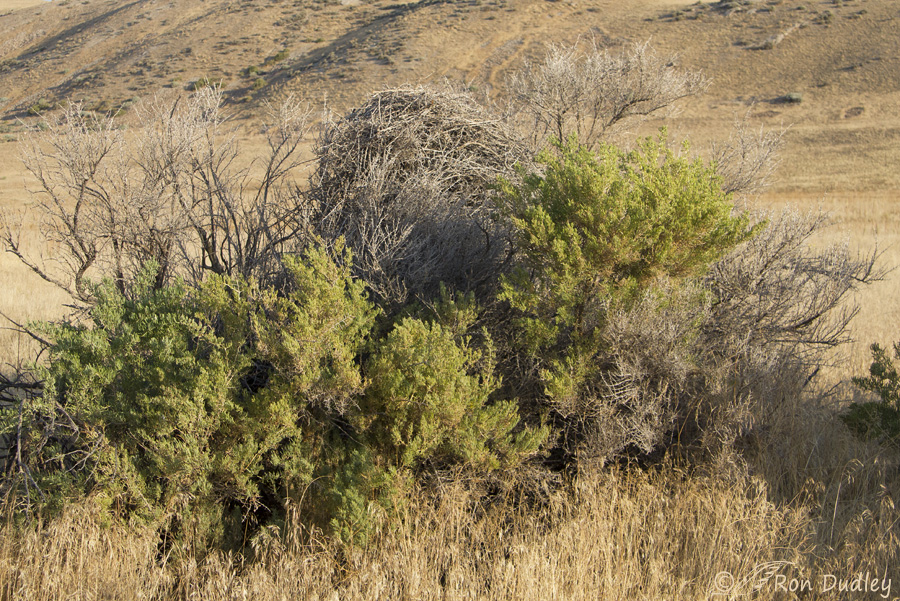
I’ve been photographing Black-billed Magpies in the vicinity of this nest for about seven years but for most of that time I haven’t been able to see it well because when it’s active it’s been mostly buried in the greenery of the greasewood bush the nest is built in. But that greasewood is dying so each year I can see more of the nest. A few days ago I took some time to study it since it’s inactive now and most of the magpies in the area seem to have been chased off by the recent fire and smoke on Antelope Island.
Some interesting facts about Black-billed Magpie nests:
- Nests are durable, domed structures made of sticks and twigs and contain an interior mud cup and lining
- There’s considerable structural variation in the nests which suggests that cultural traditions influence their construction (perhaps magpies imprint on their natal nest)
- Evidence suggests that the domes over their nests evolved recently, perhaps in response to predation from other birds
- Nests may last for many years (as this one has). When a nest is reused it may not be by the original pair that built the nest. Older nests get a new interior mud cup and lining of grass, rootlets and animal hair
- Thorny twigs (usually from greasewood or hawthorn) are used to build the dome when available. The advantage of this is obvious
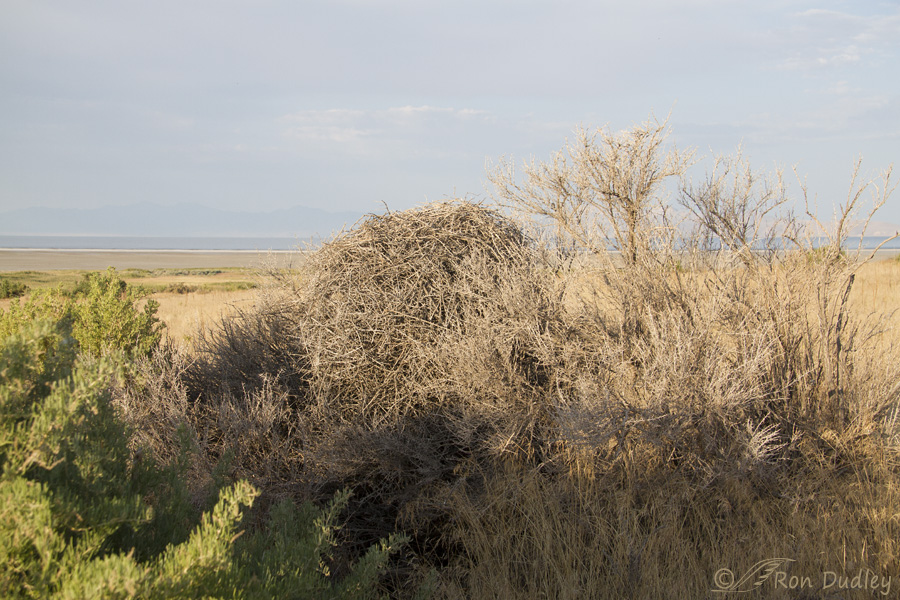
Here’s another look at the nest from a different angle.
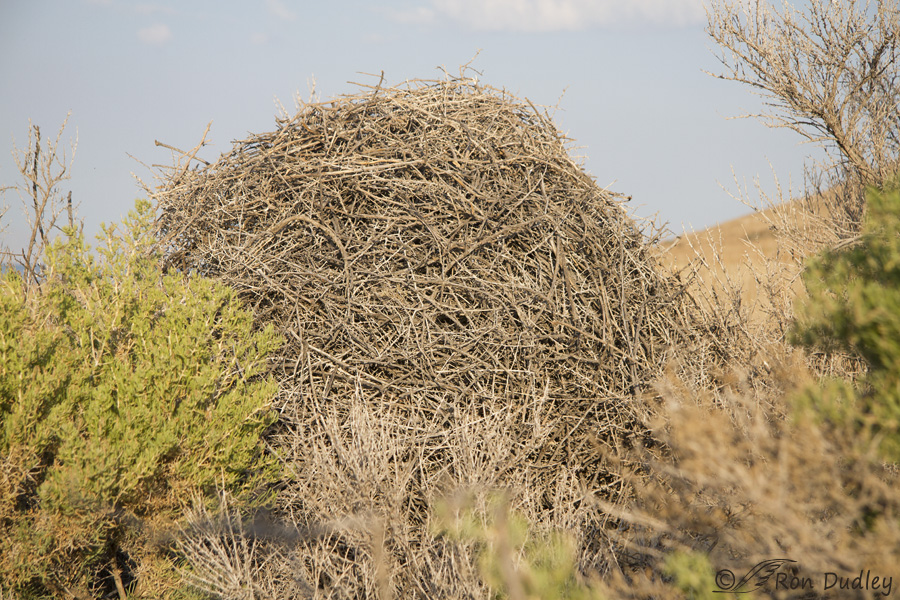
And a close-up to show details of construction. Over the years I’ve photographed many of these twigs as they’re being brought to the nest during construction (they refurbish the nest annually).
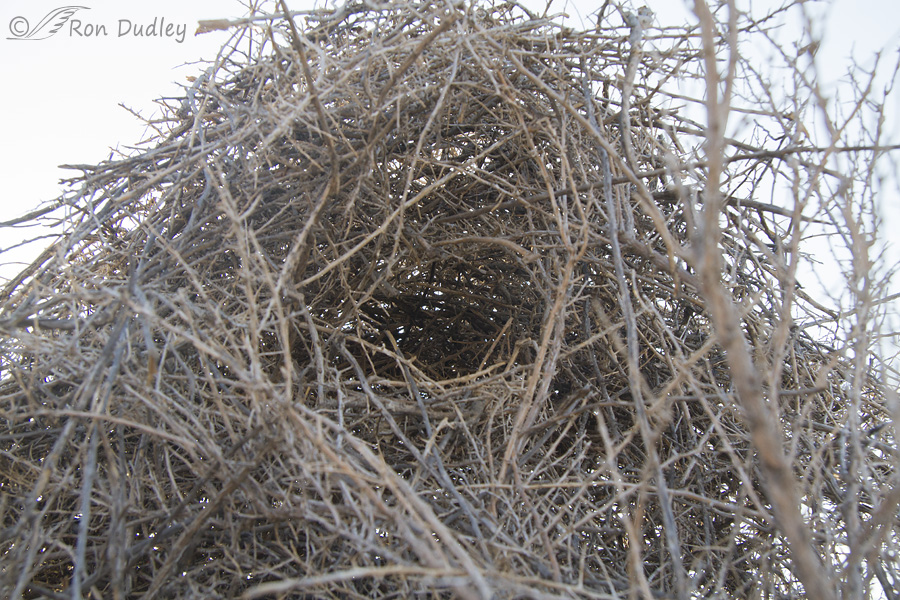
I’ve been curious about the primary entrance tunnel to the nest for years but until four days ago I never approached closely enough to see it. I looked inside and the mud cup and nest lining are now gone, presumably washed away by rains.
This image is misleading – it looks like there’s a straight, level shot to the nest interior but in order to even see the entrance I had to squat down and then look up. Even then it was hard to see.
I have my doubts that this nest will be used again. So much of the large greasewood is now dead that the nest is quite exposed and much more vulnerable. If that’s the case I’ll miss the activity here, partly because some of my favorite magpie images were taken at this location.
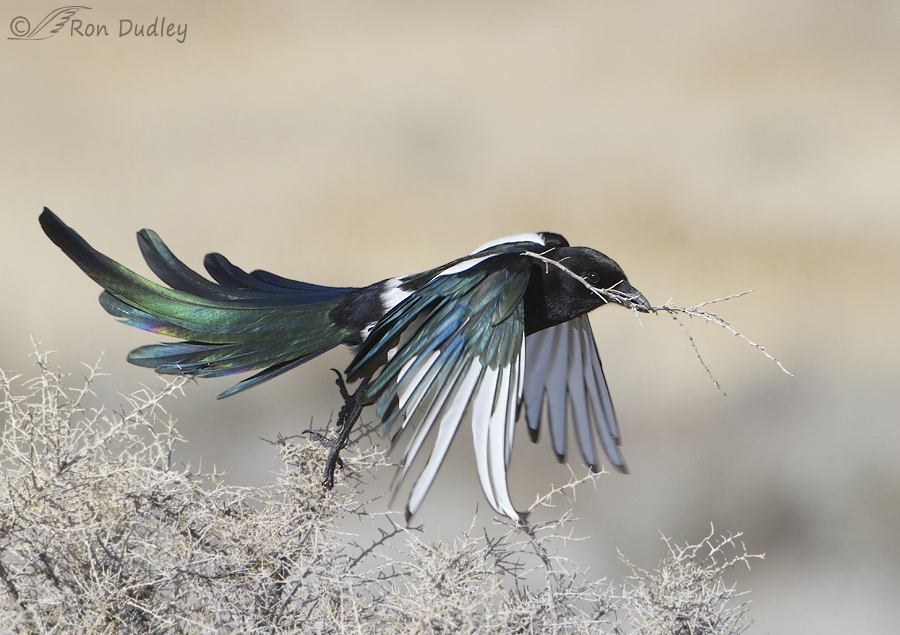 1/2000, f/8, ISO 400, Canon 7D, Canon EF 500mm f/4L IS USM, not baited, set up or called in
1/2000, f/8, ISO 400, Canon 7D, Canon EF 500mm f/4L IS USM, not baited, set up or called in
This is one of them. I took this shot 6 1/2 years ago as the magpie was taking off with a twig for the same nest I’ve featured in this post (I’ll bet the twig is still in the nest somewhere). Most regular readers have seen this image before but I couldn’t resist another look.
Ron
Note: As always, I never approached the nest closely during nesting season to avoid disturbing the birds and I always photographed them from inside my pickup.


Amazing photos! First time I saw a magpie nest. Yesterday I saw a video appearing to be having a small funeral for one of their friends who got hit by a car. They covered him with grass, gathered around him, then one by one, flew away. I hope to see them someday. Thanks for showing us this nest and for the great photos.
I once had a glimpse of one of those magpie funerals from a distance, Debbie. I’d love to be able to document the behavior one day.
Seeing this and learning from you suggests to me that Native Americans may have learned a way to build their wigwams from structures such as this! Thanks so much!
Who knows, Sandra – could be.
Thanks so much for these interesting photos! Even though magpies nest in our yard I have never been able to see much of the structure. From watching them enter the nest, it looks as though they drop down to the cup.
Thanks for these shots. Probably the best view I’ll ever get!
Jane, I once had magpies nesting in my own yard. Didn’t get much sleep after 4AM back in those days…
That magpie shot is ALWAYS a treat.
And thank you so much for a look at that amazing structure. And the reminder that birds are not only builders, architects and nurturers but that they have a culture.
Our own magpies are much more primitive in their construction styles…
EC, I’ve heard Australian Magpies described as one of Australia’s most accomplished songbirds. Ours are no singers, that’s for sure so perhaps it all evens out… :).
I do love our magpies warble. However, many of our native birds are NOT musical, so they don’t have a great deal of competition. We have rather a lot of skwarkers and screamers. And the wattle birds who start their asthmatic cough well before sparrow fart.
BINGO! EUREKA! SCORE! One of my favorite images of one of my favorite birds( a crow in a tuxedo), a wonderful new song about that bird and an image of a brown cowpony that looks a lot like one of my first horses, a brown,bald-faced snubbing pony named Baldy Socks that didn’t like anybody but me!(cubboard love)…he only half-heartedly crow-hopped with me but bucked, kicked and bit others. Love the close up of the nest, too. my lucky day!!!
Good, your lucky day, Patty. I liked that song too – thought it was cute and on target. Enjoyed the tune too.
One of my top 5 favorite images, Ron. One of my top 5 favorite birds too. A score for me today!!!
Thank you for all the information, history and of course, gorgeous photography.
Thanks for that positive feedback, Leslie.
Magpie nests are fascinating. I’ve never been able to look inside because where I lived in Colorado, they built medium-high in trees. What a complex structure! And who needs thumbs?

I particularly like your comment, “There’s considerable structural variation in the nests which suggests that cultural traditions influence their construction.” We humans don’t often consider that other creatures have cultures, specific societal norms, lifeways and the like. Or that they have their own language(s). But they do and we need to begin listening to these things from which we can learn a lot. At least, that’s what I believe
Oh and the Magpie shot? That’s the first time I’ve seen it, so continue to recycle it periodically. It’s up there in the spectacular range and new folks are always coming in who haven’t seen it.
Thank you again!
This was my first time to see into a magpie nest too, Laura. I felt like a peeping Tom…
HAHAHA Ron! That would only have been true if the family were still living there But then, there would have been serious mayhem, too!
But then, there would have been serious mayhem, too!
Boy is that ever the truth!
Magpies are magnificent and thanks to you Ron Dudley, I learned something this morning while sipping my morning coffee! That nest! the dome! I had no idea…
Coffee and magpies – a good combination, Susan. Especially since one usually can’t sleep when they’re around…
Boy Ron, that is a huge magpie nest. You always have such interesting post for everyone to enjoy-thanks. If anyone is interested there is a song on youtube sung by Ian Tyson called Magpie. It is the only song I have ever heard dedicated to the life of a magpie. For those who would like to listen to a country tune, and wanting to see a few more photos of magpies, it is a fun watch.
That’s a fun song, Marvin. I hadn’t heard it before. He obviously knows something about magpies – one of the lyrics says about magpies “you build a big house with a front and a back door”.
Here’s the link: https://www.youtube.com/watch?v=z7o9-Anzrso
Wow, thanks for all the information and the pictures of the nest. We don’t have magpies here and the first time I saw one was on a trip to Wyoming a few years ago. That’s a beautiful picture!!
Thanks very much, Carol.
I never get tired of this image, Ron. Feel free to repost again!
Ha, thanks, Diane but I think I may have already overdone it…
That is a very large magpie nest. The post is interesting. I have always liked magpies and observed them since I was very young. In the past I noticed some magpies built domes and others did not. Now to me it seems all the magpies in the area have domes and much denser nests in general. I have also noticed crows. I do not remember crows in Salt Lake and Centerville where I grew up until about 10 years ago. I have watched crows tear apart magpie nest and take eggs and young. Do you think the increase in the crow population has anything to do with the dome construction?
Thank you again Ron, for your donation and good PR to the rehab. I posted late last night.
April, BNA Online mentions crow (corvid) predation on magpie nests in particular as a possible reason for the evolution of dome-building behavior.
I’ve observed the same thing you have about the relatively recent influx of crows in urban areas of northern Utah but I just don’t know if that expansion of their range influenced any increase in dome construction. Interesting to ponder though…
Impressive for sure! Have noticed over time they raid an old nest for materials and then the Great Horned Owls will take one over and REALLY rearrange things. As an aside, a Magpie family is a pain, but a family of Grackles in the yard is worse as far as noise!
As an aside, a Magpie family is a pain, but a family of Grackles in the yard is worse as far as noise!  Thanks for the photo’s and close ups – ours are generally WAY up in trees so a close look isn’t possible.
Thanks for the photo’s and close ups – ours are generally WAY up in trees so a close look isn’t possible.
“Have noticed over time they raid an old nest for materials”
They sure do, Judy. I see them doing that a lot. I read that they recycle the dome twigs in particular, presumably because they tend to be thorny.
Wow! That’s amazing and that is my favorite Magpie shot!
Charlotte
I’m glad you like it, Charlotte. Thank you.
Thanks Ron, great and interesting post.
Thanks, Dick.
Fascinating post especially the information that the dome is a relatively new evolutionary addition proving that animals continue to adapt to stress from predators and the environment.
Thanks, Melanie. Yes, evolution (both behavioral and anatomical) is still an ongoing process.
I loved this post—the nest appeared to be very large, but I couldn’t find a visual comparison within the images—-what estimate would you give as to its
diameter ?
Kris, my guess is that it averages about 4 1/2 feet in diameter. I should have measured it or put something in one of the images for scale…
I’m amazed at the size of the nest, and at the fact that even though it appears to be very dense, that there’s so much space between the twigs. I’m guessing they would fill in some of those spaces when refurbishing the nest. If they don’t use the nest again, I know I’ll miss seeing the yearly Magpie shots. You have definitely gotten some wonderful ones. I’m liking this one more and more. Is it same one you have hanging over your fireplace?
“Is it same one you have hanging over your fireplace?”
Yup, one and the same, Susan. It’s not only my favorite magpie image (of mine) but one of my favorites of all time of any species.
Love that shot of a flying Magpie…. and thanks for the biology lesson. ;-)))
Thank you, Roger.
Wonderful post, Ron. I had no idea that their nests were so huge! And, I love this final Magpie shot!
Those nests are major constructions, Sharon. It’s no wonder they reuse them. Thank you.